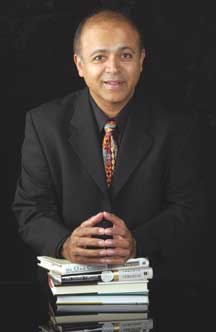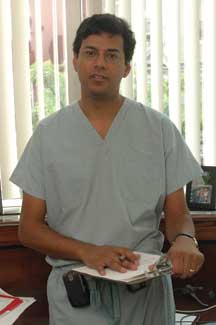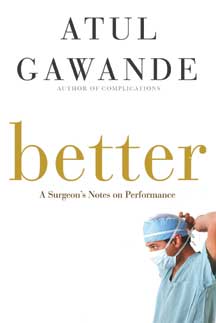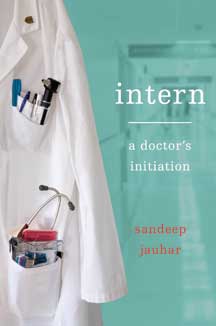Arts
A Writer In The House?

Quick! We need a heart by-pass!
| They can turn an evocative phrase as deftly as they can excise a tumor or heal a heart. They may not be able to write a decipherable Rx, but they can pen evocative words full of clarity, beauty and often deep insights into their profession
We are talking of the intriguing tribe of physician-scribes who are as at home in the ER or operation theater as they are in the universe of the written word, of magazines, newspapers and books.
The doctor-writer tradition goes back a long time, to Anton Chekhov and Somerset Maugham. Given the large number of Indian physicians in the United States, it was only a matter of time before some began wielding the quill. From physician-novelist Dr. Sanjay Nigam to Dr. Sanjay Gupta, who besides being a neurosurgeon is also a correspondent for CNN, a columnist for Time magazine and the author of Chasing Life. In recent years, a handful of Indian physicians have broken through into the world of medical literature: Dr. Abraham Verghese, Dr. Atul Gawande and now the latest entrant, Dr. Sandeep Jauhar has each written honestly and with introspection about the complex world of medicine, taking us through the rabbit hole into a place we hardly know. Verghese did his internship and residency in Johnson Hill, Tenn., and worked at the University of Iowa’s AIDS outpatient clinic. At the same time he attended the noted Iowa Writers Workshop, and bit by bit, his everyday encounters became grist for his first book, My Own Country: A Doctor’s Story – a powerful memoir about working with AIDS patients in rural Tennessee, and in the process, finding himself. The New York Times Book Review called the book “an account of the plague years in America, beautifully written, fascinating and tragic, by a doctor who was shaped and changed by his patients.” It was a finalist for the National Book Critics Circle Award and selected by Time magazine as one of the five best books of the year. It was also made into a Showtime movie directed by Mira Nair and starring Naveen Andrews. His second book, The Tennis Partner, about the drug addiction and death of his friend, a young medical student, was a New York Times notable book and a national bestseller. Verghese has written for many publications including Granta, The New York Times and Wall Street Journal. For the last ten years he has been working on his next book, Cutting for Stone, which will be published by Knopf soon. He observes that in medical school you are taught to observe, pick up on details and bring it all into a diagnosis, which are factors fundamental to the process of writing too. “I often feel I write in order to understand what I’m thinking. When I start to write, then it starts to emerge, a sort of secondary, tertiary understanding that I wouldn’t have had if I hadn’t tried to write it. So that’s the part of writing that I think is utterly mysterious and enjoyable,” he says.
Verghese, who was professor of medicine and chief of infectious diseases at Texas Tech Health Sciences Center in El Paso, Texas, later became the founding director of the Center for Medical Humanities and Ethics at the University of Texas Health Sciences Center in San Antonio. “The humanities are vital in helping students maintain empathy with their patients,” he says. “Students come to medicine with a great capacity to imagine the suffering of others. In their clinical years, however, they are taught to take the patient’s unique story of illness and translate it into the depersonalized language of the chart. We want to keep alive their innate humanity, integrity and empathy.” Verghese, who was recently appointed the senior associate chair for the theory and practice of medicine at Stanford University, has just moved to Palo Alto with his wife Sylvia and 10-year-old son (his two older boys are both in college, studying literature). “One of the beautiful things about this position is that for the first time in my life I have a 40 percent protected time to write.” he says, “So I’m bringing about the separation of the two roles something that I never did before. It’s delightful. I feel I’ve finally earned the ability to do that.” He’s come to Stanford as a tenured professor with tenure, which is generally reserved for those with research grants and scientific breakthroughs under their belt. He says, “It’s just very humbling to see how over time the effect of my writing has been that it’s taken to be the equivalent of scientific research. I think it’s looked at as seriously a contribution as research and that’s really gratifying to me.” Besides his writing, Verghese will be responsible for third year medical students on rotation in internal medicine, something typically delegated to junior faculty: “To me, it’s a great privilege and honor, because it’s precisely the thing that I consider terribly important, a moment to shape them.” He enjoys the position because it gives him time to interact with students and patients. Now that he has a small office of his own and the time to write, Verghese wants to explore with the pen how medicine and his own thinking are evolving. “We have never had more ability to bring patients a cure or better their medical conditions, yet I think there has never been a time when patients have been more dissatisfied with medicine.
“It’s a very strange paradox. Science is at this brilliant phase where we are curing some cancers with a single pill, but the public, I think, feels quite the opposite, that medicine is getting further and further away from the patient, from one human being interacting with another. It’s more like you’re getting swallowed up by a system when you have an illness and being farmed out to all these tests and specialists.” He feels the real issue of the day is to balance this almost mathematical, scientific model of disease with our need as humans to have someone to give us comfort, reassurance and company through the course of a long illness. He says, “That’s what intrigues me the most right now.” It is also something that intrigues Atul Gawande, another physician who has delved deep into his profession – warts and all. His first book, written while he was still a resident, Complications: A Surgeon’s Notes on an Imperfect Science turned the searchlight on a resident’s life and was a finalist for the National Book Award in 2002 and was published in more than a 100 countries. Gawande juggles several balls: he is a surgeon at Brigham and Women’s Hospital, assistant professor of surgery at Harvard Medical School, assistant professor in the Department of Health Policy and Management at the Harvard School of Public Health, and associate cirector for the BWH Center for Surgery and Public Health. He is also the director of the World Health Organization’s Global Challenge for Safer Surgical Care. Into this hectic lifestyle he also embeds his writing, as a staff member of New Yorker magazine, and author of two books. In 2006 he received the MacArthur “Genius” Award for his research and writing, and his articles have appeared in the annual Best American Essays and in Best American Science collections.
In Complications, Gawande was trying to find answers to the questions which were perplexing him about the medical field. He says, “It was written from the perspective of someone who was just starting out in medicine. I was trying to understand in that set of stories how and why medicine is imperfect and if medicine is imperfect, how do we become remotely competent?” Now five years later as his journey into the medical world continues, he’s written Better: A Surgeon’s Notes on Performance. “Over the last few years I’ve been trying to answer a slightly different set of questions,” he says. “I feel I may be competent at what I do, but there’s a slightly harder question: what’s the difference between those who are merely competent and those who are good? What makes medicine particularly interesting is that failure is so easy; it’s right around the corner.” He has not only written about the possibilities of errors and human failures in medicine, but has also worked to bring about real-life changes. Through initiatives at the Center for Surgery and Public Health at Brigham and Women’s Hospital, Gawande is working to improve medical practice with innovations like bar codes to prevent surgeons from accidentally leaving sponges and instruments in patients. He says: “For the last eight years, my research agenda has focused on making advances in two areas: understanding and ultimately reducing injuries from error in surgery; and improving policies affecting the provision of surgical and medical care. More recently my work has expanded to address questions in global health – in particular, how to meet the growing demand for care for surgical diseases in poorer Sandeep Jauhar: “If I knew then what I know now about journalism, I never even would have thought Better is all about going that extra mile, of crossing the chasm from average to being better. He tries to analyze what makes a doctor fight the odds and get better results. Why is it that at an average hospital center you have a 33-year life expectancy while some of the best centers give you a chance of a 47-year life expectancy? Can one take the know-how that exists at the top of the bell curve and take it elsewhere? For Gawande, writing about these issues brings some clarity, if not answers. If you’re a patient and stymied by the frightening hospital labyrinth, think how confused and terrified a new intern feels! For the most candid and colorful depiction of these turmoils, one has to turn to Intern: A Doctor’s Initiation – a medical memoir by Dr. Sandeep Jauhar, who is now head of the Heart Failure Center at the Long Island Jewish Hospital in New York. It’s a hard-to-putdown book as you follow the reluctant doctor-to-be passing through the fire of medical training to emerge a full fledged healer. The book received glowing praise. Reviewer Robert Coles wrote: “Told of here is a time of travail and testing – a doctor’s initiation into the trials of a demanding yet hauntingly affirming profession – all conveyed by a skilled, knowing writer whose words summon memories of his two great predecessors, Dr. Anton Chekhov and Dr. William Carlos Williams: a noble linage to which this young doctor’s mind, heart, and soul entitle him to belong.”
It did not come easy. Sandeep Jauhar, who was completing his Ph.D. in physics at Berkeley came to the medical field late, torn between different professions, including journalism. Although his older brother was a doctor, medicine was the last thing Jauhar had wanted to pursue. In Intern he writes, “Medicine was so bourgeois! My father admonished me for being impractical. He wanted me to become a neurosurgeon-one trained at Stanford, no less. To him, that was the apogee of professional attainment… But I wanted nothing to do with my parents’ dream. In immigrant Indian culture, youthful rebellion is saying no to a career in medicine.” He had always been passionate about journalism: “On Sunday mornings the voice of David Brinkley was as familiar as my mother’s urging us to come to the table for her potato parathas.” Before entering medical school, he applied for and was surprised to get a prestigious science journalism fellowship, which led to a summer working at Time magazine in Washington DC. In the book he relates an amusing incident while interviewing with Gerald Boyd, then a senior editor at The New York Times, without clips or reporting samples, just story ideas in his backpack. When told he could not be hired, Jauhar with all the optimism or foolhardiness of youth asked, “Why not?” Told brusquely that he was unqualified, he still managed to make connections during that this initial visit. Although he was not successful then, his byline has appeared frequently in the paper. “That was just another example of how important it is, sometimes when you’re young, not to know your own limitations, not to know what the etiquette is,” he says. “If I knew then what I know now about journalism, I never even would have thought of going to the top editor at the New York Times and asking him for a job. It was ridiculous but in the end it served me well.” Asked if he still experiences a tug of war between being a physician or a journalist, Jauhar says, “I’ve virtually reconciled, in the sense I am first and foremost a doctor. That is my fulltime job, but I’m very lucky in that I’m able to write about medicine and I have venues like the New York Times where I can explore and develop my writing interests. So I feel very lucky to be able to do both. To me my writing informs my medicine and my medicine informs my writing and so it’s sort of an organic process.” “I think there is evidence to suggest that literature and humanities can potentially improve one’s doctoring, possibly by making more empathetic physicians, but there’s no evidence that I’m aware of that having a consuming passion like writing can make a better doctor.” He adds, “What I like about writing is it allows me to explore some of the questions and conundra that come up in clinical practice and allows me to go a little deeper. So in that sense, my interest in writing about medicine forces me to examine issues in medicine a little more deeply than if I wasn’t writing.” Jauhar says his typical day revolves around the Long Island Jewish Hospital where he heads the Heart Failure Program, treating inpatients every day and outpatients several times a week. He also staffs the Cardiology Fellows Clinic once a week. He returns home to play with his three-year-old son Mohan and reconnect with his wife Sonia, who is an endocrinology fellow, over dinner. Late in the evening when everyone’s gone to bed, he usually heads to his computer to do a little writing. Before his medical training, Jauhar had thought of medicine as “a cookbook craft” with little room for creativity. Now he believes there is: “I think the creativity is not in the mechanics of treatment, but it’s in how you deal with the patient, how you advocate for them, how you explain to them what’s going on, how you communicate with them. I think that’s how your personality can be expressed.” Having agonized about a career in physics, medicine or journalism, what advice would he give to similarly conflicted souls? He says it’s important to figure out what you really want to do – and it took him really a very long time to figure that out. “I went to physics, partly out of interest in the field, partly to prove to myself that I was able to do it,” he says. “I switched to medical school when I was 26 and started writing for the New York Times when I was 30. I wasn’t an English major, I didn’t write for my college newspaper, but I was able to engineer the transition because it was something I was very interested in doing. “As one of my advisors at Berkeley once said to me, ‘Figuring out what you really want is the hard part – getting it is the easy part!'” |





